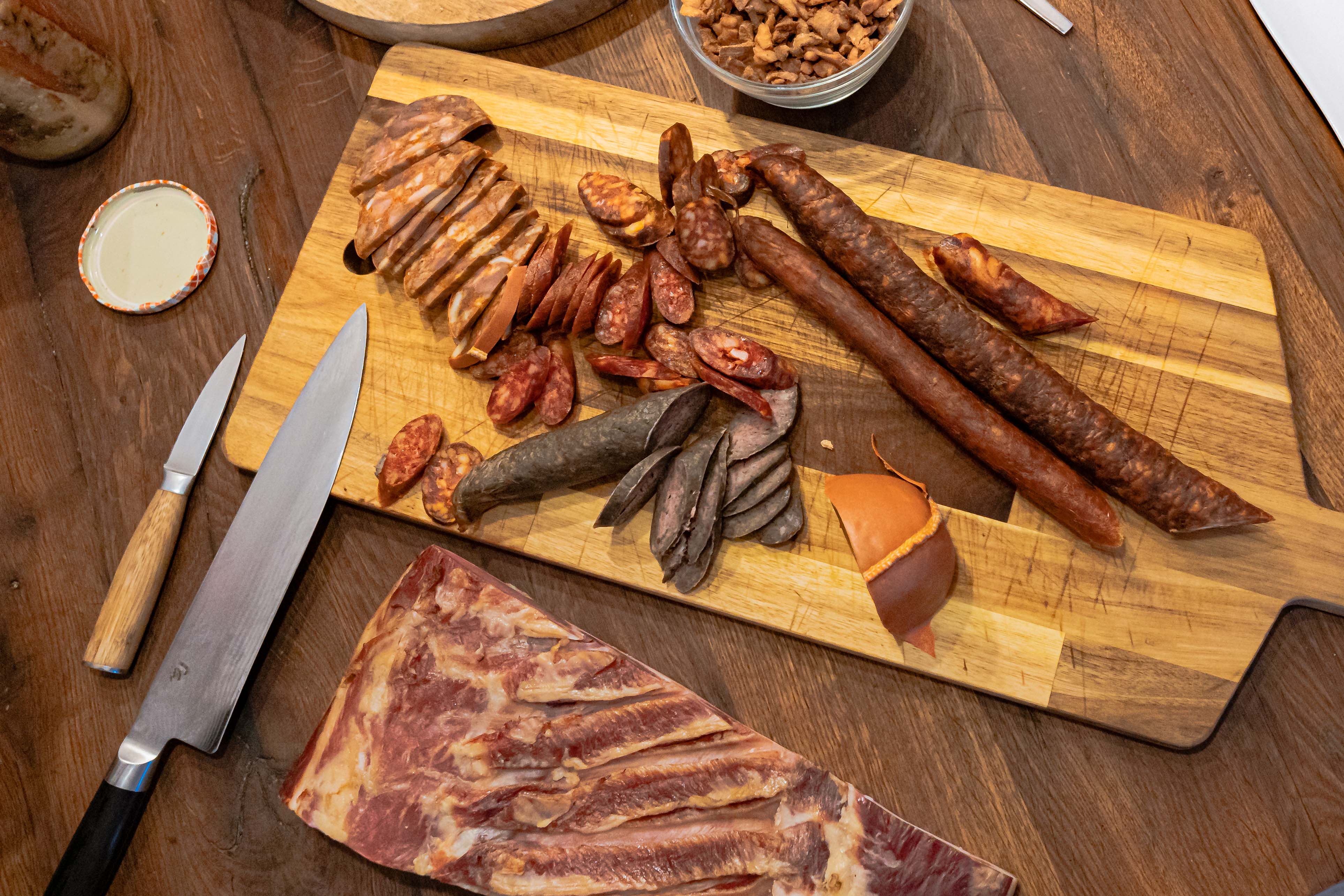Osijek Street Race Show is Back This Weekend for its 29th Edition
May 25, 2023 - The fastest weekend in Slavonia and Baranja has been announced at 998 Garage! The long-awaited 29th Osijek Street Race Show is taking place on May 27 and 28 at the Čepin - Osijek Sports Airport, and it's expected to gather around 200 competitors and about 6,000 visitors, making Osijek the centre of extreme sports for a weekend.
As SiB writes, the city of Osijek, the organization, and friends of the event contributed to one of the most visited sports competitions in Osijek and eastern Croatia in general. Deputy Mayor of Osijek Dragan Vulin, HAKS President Davorin Štetner, HAKS Motorsports Committee President Dragan Serden, and the main organizer and president of the "Slavonija" Auto Club Rudolf Kalkan announced the event at a press conference.
According to Rudolf Kalkan, we can expect the biggest Osijek Street Race Show to date: "This is also the 15th anniversary of Auto Club Slavonija, which makes this event even more significant!" Dragan Serden emphasized this special day for Street Race because this discipline was declared a sport in HAKS exactly eight years ago, and he expressed his satisfaction and love for the City on the Drava, to which he is always happy to return!
"The whole team is doing a great job; a lot of effort, sacrifices, sleepless nights, and a great amount of enthusiasm have been invested, without which this sport wouldn't even exist!" said Davorin Stetner. Dragan Vulin expressed great satisfaction and thanked the organizers for doing it all for the 29th time, which Osijek is proud of: "Osijek is a city of sports! This includes the Osijek Street Race Show. Here we also associate sport with tourism, where this event plays a big role in the number of overnight stays and visitors to this area. This is one of the events that makes Osijek a city!"
Spend the coming weekend surrounded by the fastest cars and motorcycles in a relentless test of strength! See you at the start line!
For more, make sure to check out our dedicated Travel section.
The Oscans Graffiti Jam Huge Success, Leaving Osijek with New Urban Art
May 26, 2023 - The city of Osijek truly lives its urban vibes. Last weekend at Osijek's Ante Starcevic Square, Osječka Tvornica Ideja (the Osijek Idea Factory) gathered 20 artists from 7 countries, leaving visitors of the Oscans graffiti jam speechless and delighted.
What was it all about? As we wrote, Osijek hosted a festival of urban art and culture - the Oscans graffiti jam, organized by Osječka Tvornica Ideja and Sugar Factory. The event was conceived to popularize street art, and as the organizers themselves said, no one hid their satisfaction.
The whole thing started at 10 a.m. with workshops for the youngest and knowledge transfer sessions. The judges of the afternoon's main event held a graffiti school where they taught the little ones about the basics of graffiti, art and behaviour, and culture on the streets. The workshops were packed full, whether due to the opportunity to learn from the legendary artists Dalet, Atek, and Mr. Pain or the Ledo ice cream, which all participants were gifted. Parents and children expressed their great satisfaction with the opportunity to learn and the need for more such workshops on an annual level.
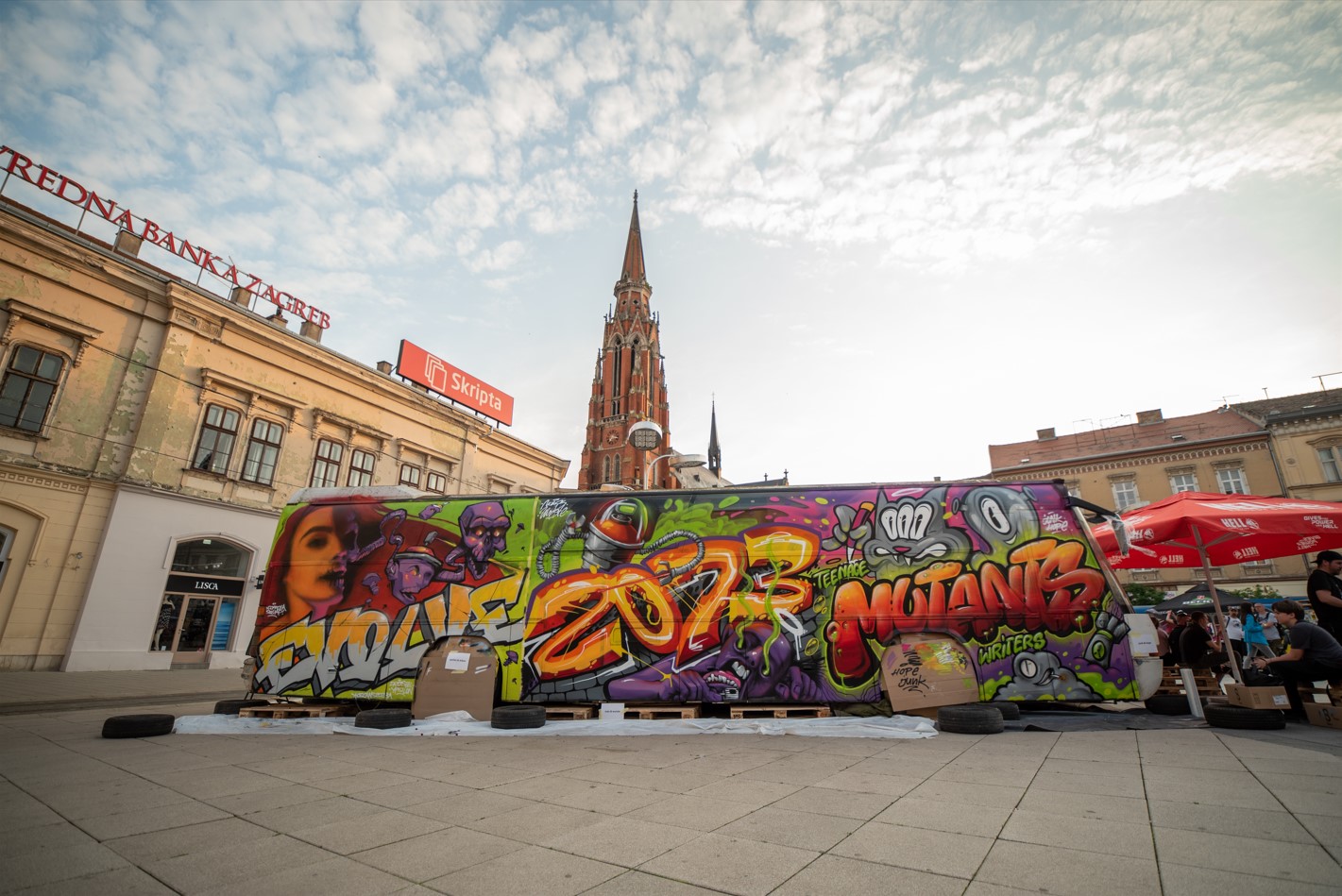
The main event started at 1:30 p.m., and just an hour before the competition, the artists received the official theme of the battle - 50 years later.
In this way, the organizers wanted to emphasize that graffiti and street art are an excellent medium for sending a message and for intervention in space and society. The task for the contestants was to show the world 50 years from today. Will it be happy and cheerful or dark and apocalyptic? What is their vision? What message do they want to send to the public?
For an hour, the graffiti artists sketched their visions on paper and figured out how they would stand out from the others and win valuable prizes. The local Osijek scene was represented by Rebus and Wasko and Moler and Heir, Croatia by Tramsky and Rancho, Hungary by Coke and Suzie, Slovenia by Azram and Boriz, Slovakia by Doke and Rems, Serbia by Wunste, Junk, Hope and Noks, Italy by Ypsilon and Dr8ste. There was a Greek-Croatian combination there as well, Snuz and Sec.
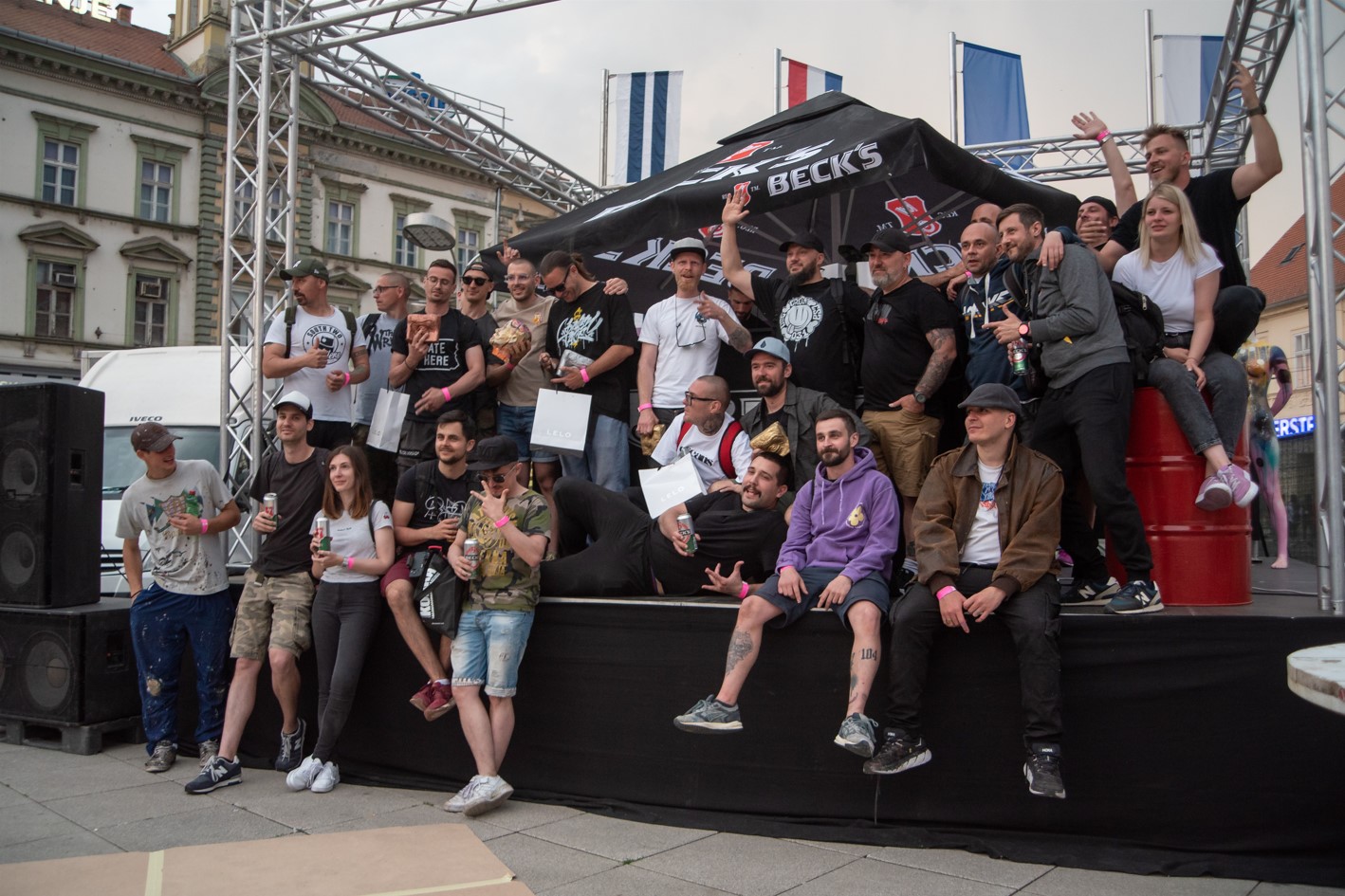
With the strike of the Osijek co-cathedral at 3 p.m., the Oscans graffiti battle began. The artists hastily took the spray cans and started sketching on the tram and two buses. As the hours and minutes passed, the vehicles received a new face, and several thousand visitors stood and enthusiastically observed what was happening and what all those patterns and lines would grow into.
At 19:00, the competition was officially over. The judges entered the scene, facing the huge challenge of choosing the best of the best. All the competitors came to their aid and participated in the evaluation by ranking their competition. The fact that only one or two points decided winners and places also speaks volumes about the level of the competition.
The team from Slovenia took first place, making the duo €800.00 richer, plus a LELO sponsorship package and a golden plaque from the School of Applied Art and Design. The second place went to the team from Serbia, Noks, and Wunste - €400.00, a rich sponsorship package, and a silver plaque. The third place went to the Greek-Croatian sensation, who received €200.00 and also got a rich sponsorship package and a bronze plaque.
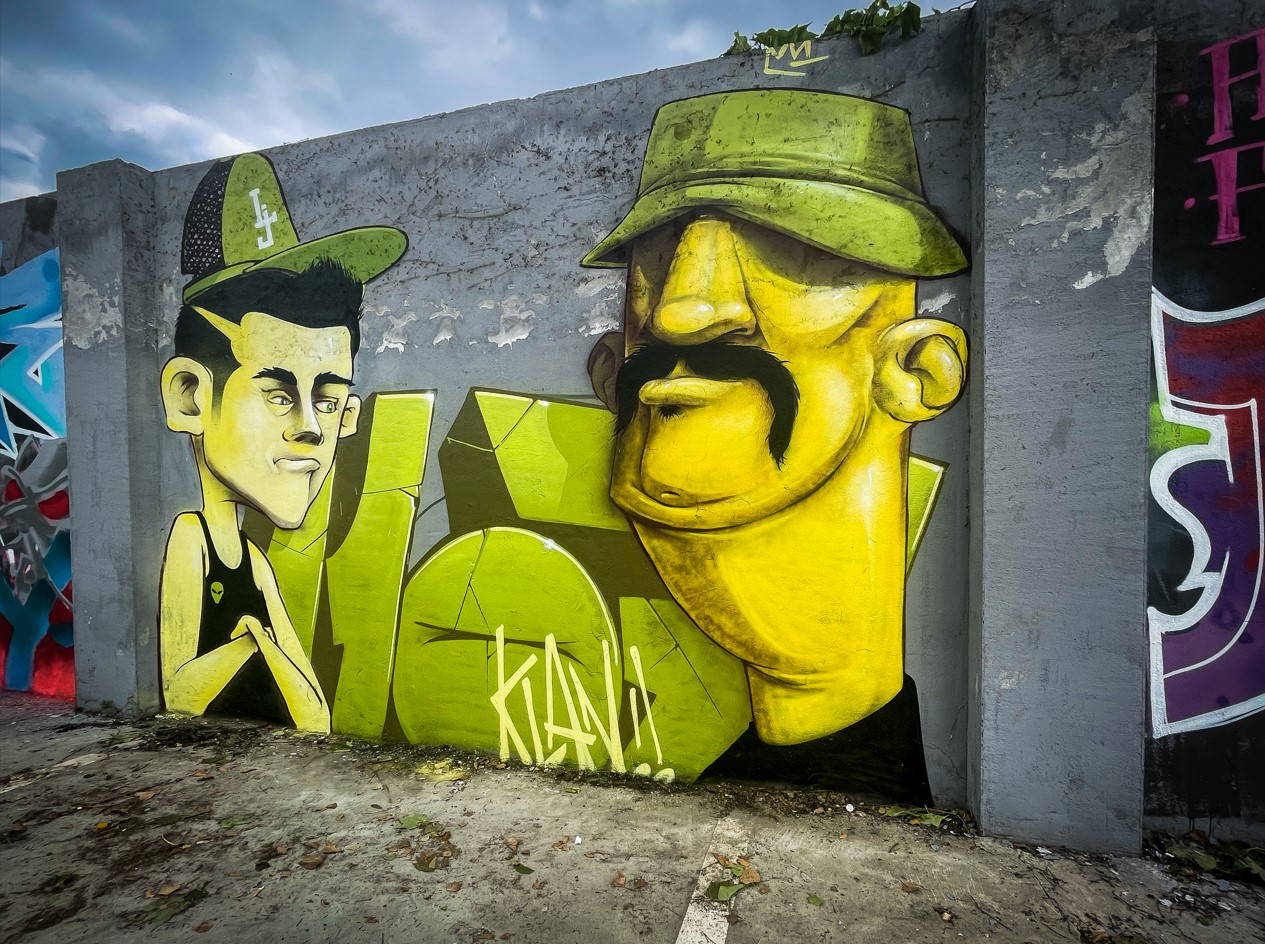
In addition to the graffiti jam itself, visitors had the opportunity to enjoy the Artbeat exhibition, a breakdance competition, and the sounds of hip hop along with a relaxing chill zone and Beck's - the official beer of the festival. The festival was fully rounded to celebrate 50 years of hip-hop culture and put the city of Osijek on the map as the center of one of the main urban spots in Europe.
But what was the "sweetest" thing for all artists? The after-battle after-party, of course. The day after the competition, most artists gathered and decorated a wall, the "Dale Hall Of Fame," and another van. In a relaxed atmosphere, many artists left a lasting mark in Osijek. They expressed their desire to come again, which speaks of the sheer quality of the organization and Slavonian hospitality.
For more, make sure to check out our dedicated Travel section.
Osijek Mosquitoes Problem to be Approached Systematically
May 18, 2023 - As the regional center of Slavonia and Baranja, Osijek is known for its history, culture, being the greenest city in Croatia, and other interesting things. Among them, unfortunately, the Osijek mosquitoes. So much so that there are statues and artwork dedicated to the little flying nuisances, festivals that have one as their logo, and even an enclosure in the bushes of the city zoo with their name. Summers in Osijek are equally fun and itchy.
This year, the city of Osijek will, for the first time, approach its mosquito problem from a wider angle by including the area of several neighboring municipalities from whose floodplains the mosquitoes come to the city. As announced by the City Administration, they expect that a more systematic approach will gradually reduce the mosquito population.
Deputy Mayor Dragan Vulin said at a press conference that for the first time since Croatian independence, the city of Osijek reached an agreement on the financing of larvicidal treatments in the area of the surrounding municipalities of Petrijevci, Darda, Bilje, and Erdut, where the largest floodplains from which mosquitoes come to the city can be found, writes Index.
Research has shown that 95 percent of mosquitoes in Osijek come from those flood areas, so the city has taken on the obligation to finance and carry out the treatment to prevent the emergence of mosquitoes in those areas, explained Vulin.
The city will finance the larvicidal treatments in total, and in addition, Vulin points out, it was agreed with the municipal authorities that 90 percent of the amount will be co-financed from the Osijek city budget for corrective adulticidal mosquito treatments, intended for mosquitoes that survive the larvicidal treatment, while the municipalities will provide the remaining 10 percent.
Planes will dust over the residential areas
Given that larvicidal treatments are not fully effective anywhere in the world, Vulin announced that Osijek would also carry out adulticidal treatments from the ground and the air in the city, and the first treatments are scheduled for this Thursday and Friday. He noted that the City Administration is having discussions with the Ministry of Economy and Sustainable Development regarding obtaining a permit for the larvicidal treatment of the peripheral areas of the Kopački rit Nature Park, as a large number of mosquitoes come to Osijek from the park's southern parts.
Vulin reported that 700,000 euros have been provided in the city budget for mosquito control this year, while the Osijek-Baranja County will participate in financing with an additional 200,000 euros.
When the funds allocated by individual municipalities are added, it amounts to more than 1.1 million euros. In addition, the City of Osijek expects help from the government, from which Mayor Ivan Radić requested funds.
Vulin believes that more than 1.5 million euros will be available for the fight against mosquitoes this year, which is more than in the past few years.
Regarding the agreement with the surrounding municipalities, Vulin says that they wanted to fight mosquitoes outside the city, which will also help municipalities that cannot provide enough funds for an effective fight against mosquitoes. This does not mean that there will be no mosquitoes at all, but it is certain that with this systematic approach, the mosquito population will decrease this year and in the following years, Deputy Mayor Vulin said.
For more, make sure to check out our dedicated News section.
Slavonia Returnees from Ireland all Agree on Several Things
April 28, 2023 - In the last decade, young people mostly traveled in one direction from Slavonian railway stations and airport terminals. After a wave of emigration to Ireland and Germany and a period spent working abroad, more and more people are returning to the east of Croatia. How do Slavonia returnees feel?
The HRT team, writes Poslovni, spoke to them about what the Croatian labor market can learn from Western Europe, what Croatia's advantages are, and how to navigate in a new country and culture.
"The number of returnees is relatively small. These are mainly people who are overqualified for the jobs they do abroad. Nevertheless, there are success stories, where people learn something, earn some money and bring it all back here," said associate professor, Ph.D., Željko Pavić, Department of Sociology, University of Osijek.
One of such is Branko's story. He went to Ireland 20 years ago and returned ten years ago - around the time of the first big wave of emigration. Now a businessman, he worked in restaurants and became a chef. He is opening his own restaurant soon.
"I learned languages, I learned a lot of other recipes, and I think now is the time to apply a little bit of that in our area here," said Branko Grozdanić from Osijek.
All returnees agree on one thing: when it comes to work culture, Croatia cannot compete with the West.
"Attitude towards the worker, progressing at work, which I think is the most important aspect. You can start as a kitchen porter today and become a manager in 2 years. It's just that they appreciate the work", emphasizes Igor Vukadinović from Osijek.
Zen went to Ireland primarily because of love. But after half a year, he realized neither the girl nor the country was the one. He had difficulty coming to terms with cultural differences and bad weather.
"The start there is quite difficult, primarily because of real estate; rents are expensive. Your first job probably won't bring you a fabulous salary," said Zen Špehar from Osijek.
Research shows that most Croatian emigrants do not plan to return to their homeland, though. Those who do not rule it out will only do it if a number of conditions are met.
"Everyone has to weigh out what is more important in life," says Igor.
"We live in the perfect position. In terms of weather, food, quality of life, everything", emphasizes Igor.
Those who strive for stability, a slower and more relaxed lifestyle that largely does not involve money, think more about returning. Unfortunately, this will only somewhat mitigate the significant damage done to Croatia by the loss of its youth.
For more, make sure to check out our dedicated Lifestyle section.
The British Telegraph Praises Slavonia as Loveliest Forgotten Destination
April 25, 2023 - The British Telegraph published a report on Slavonia, which the author Jane Foster presented as "the most wonderful secret region" that is worth visiting and experiencing with regard to its natural, cultural, and eno-gastronomic attractions.
The report titled "The little-known European region that's making wine for the King's Coronation" was created in collaboration with the London representative office of the Croatian Tourist Board and the editorial staff of the Telegraph after the author visited the region in February.
Slavonian cities, nature parks, and numerous well-known wineries that nurture traditional wine production along with the local gastronomic offer are part of the details the Slavonia report highlights, particularly emphasizing places like Iločki Podrumi and the Traminac wine variety.
As they note from the Croatian Tourist Board, that wine has traditionally been consumed at the British Court since the coronation of the late Queen Elizabeth II and will be served at the coronation of King Charles III in London, one of the most important events in recent British history.
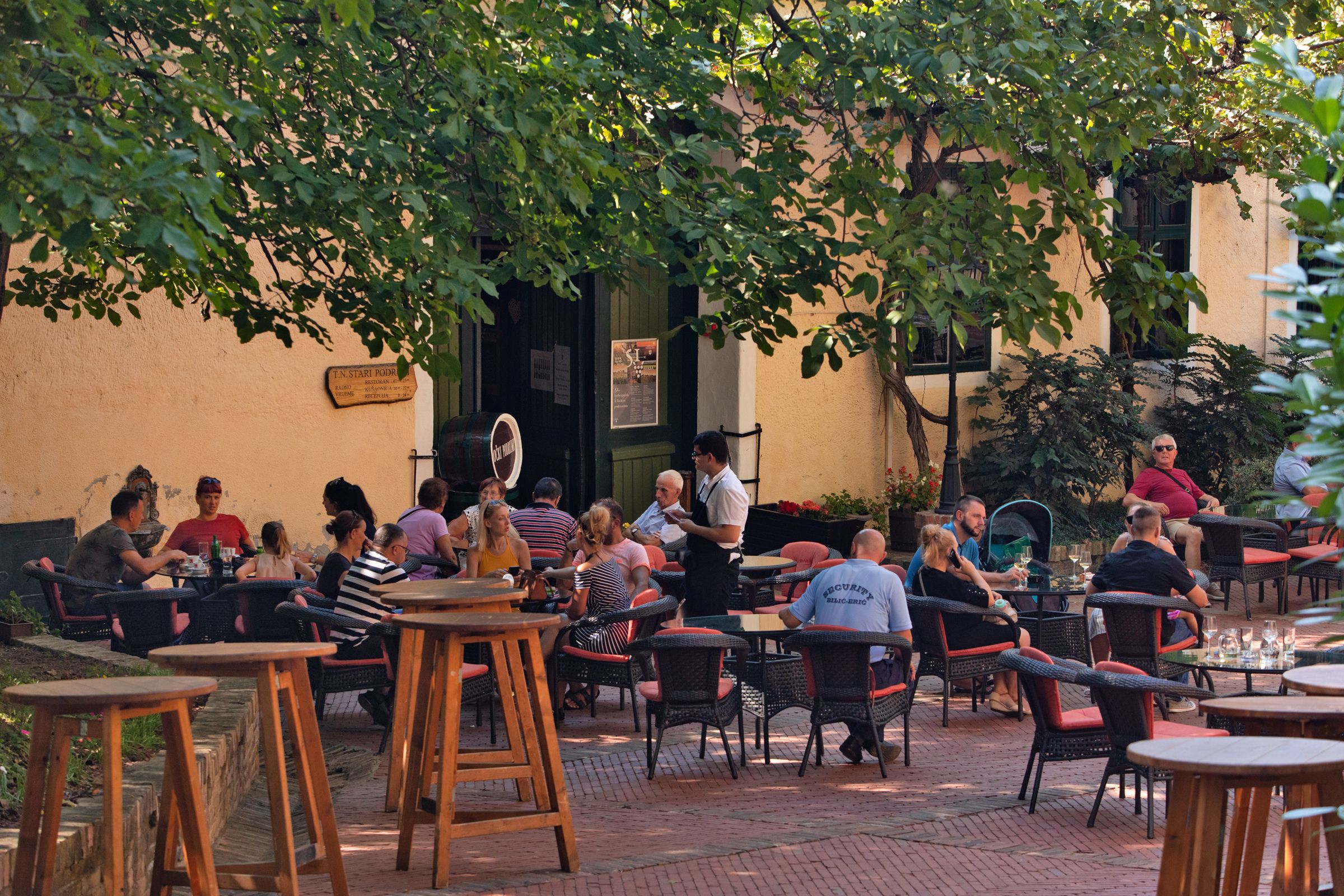
Copyright Romulic and Stojcic
"In 1953, Ilocki Podrumi supplied Traminac for the coronation of Queen Elizabeth II; in 2011, they sent ice-harvest Traminac for the wedding of William and Kate; and in 2018, berry harvest Traminac for the wedding of Harry and Meghan.
Tradition being tradition, they will be sending Traminac Principovac (a semi-sweet white wine, produced in a limited edition) as a gift to Charles III and Camilla for their coronation on May 6, 2023".
In her report, Foster praises the local wine tradition, cultural wealth such as the old city center of Osijek and Ilok, as well as the special features of Vukovar and the wealth of flora and fauna of the Kopački rit nature park.
The Croatian Tourist Board adds that "the synergy of rich cultural heritage, numerous events, and natural beauty makes Slavonia a winning destination with a luxurious tourist offer for all markets, including Great Britain."

Copyright Romulic and Stojcic
They also note that the new direct Ryanair flight on the London-Osijek route, which will operate four times a week from June and contribute to the traffic availability of Slavonian destinations, will contribute to the additional attractiveness of Slavonia on the UK market.
And the data from the Croatian eVisitor system confirms positive trends from the British market, writes Poslovni. "Positive trends from the British market are also confirmed by the data of the eVisitor system, according to which tourists from that market have spent almost 153,000 overnight stays in Croatia so far this year, or 3 percent more than in the same period of record 2019," concludes Croatian Tourist Board.
For more, make sure to check out our dedicated Travel section.
Museum of Becarac in Pleternica: All You Need to Know About Slavonia
March 24, 2023 - A new pearl of tradition has been formed right in the heart of Slavonia - the Museum of Becarac Interpretation centre offers an entirely new impression of this region.
Can Slavonia compete with Dalmatia and Istria, the generators of tourism in Croatia? The answer is simple - no. And it doesn't need to. Croatia, as a very colourful country, geographically, climatically, and in terms of food and gastronomy offer, cannot have competition between its regions but rather have them complement each other for the complete tourist offer of the country.
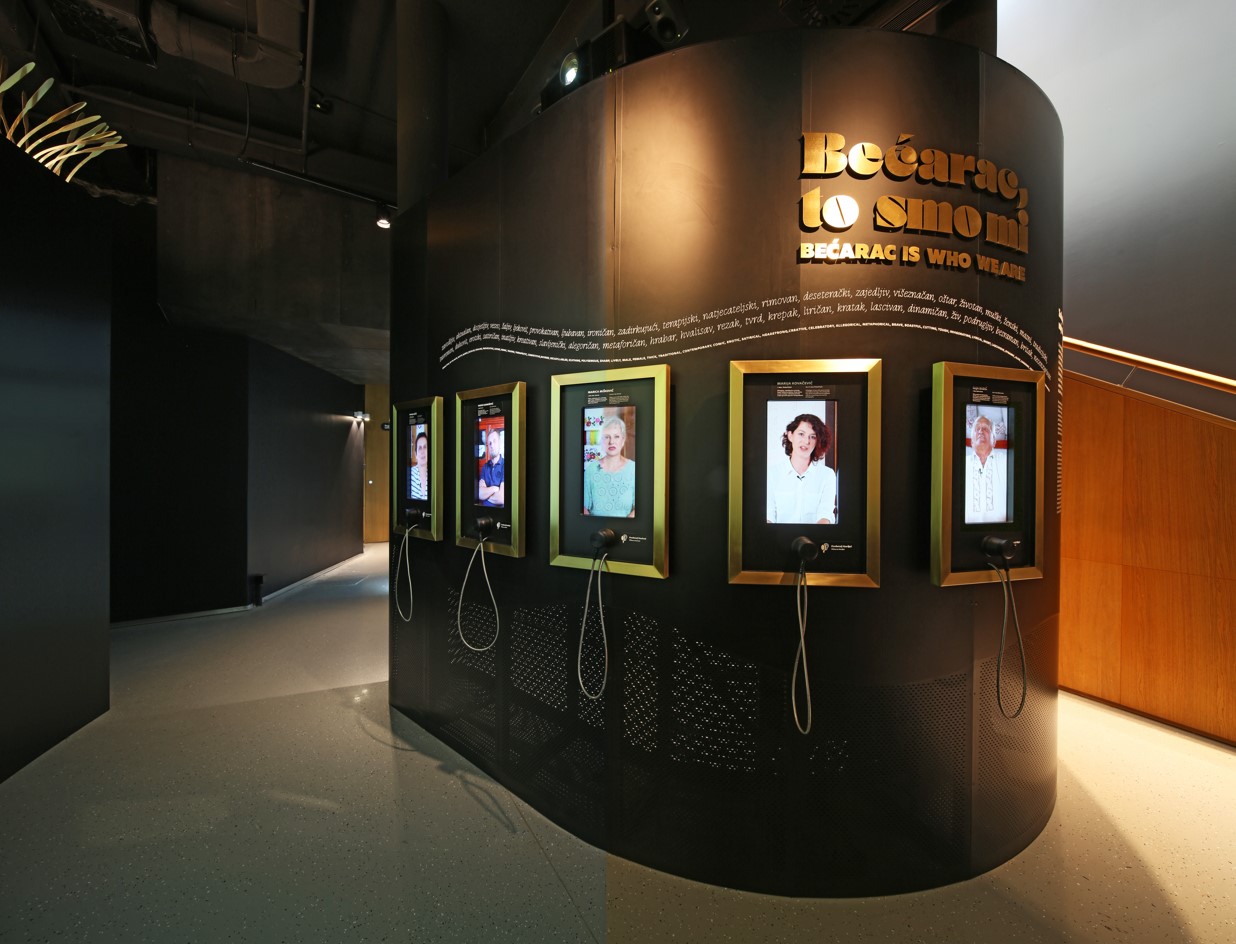
At the first mention of Slavonia and tourism, many people wave their hands because they see Slavonia as a region of agriculture, but those who know a little better, even those who have scratched the surface of what Slavonia has to offer, see how things are changing. And not spontaneously and in an unplanned manner, but strategically. Traditional manifestations are being strengthened, the regio's presence at tourism fairs is increasing, and awareness is being raised about its wine and gastro offer. However, one of the key things is the infrastructure, various centres offering all kinds of content, which are being built and renovated in Slavonia.
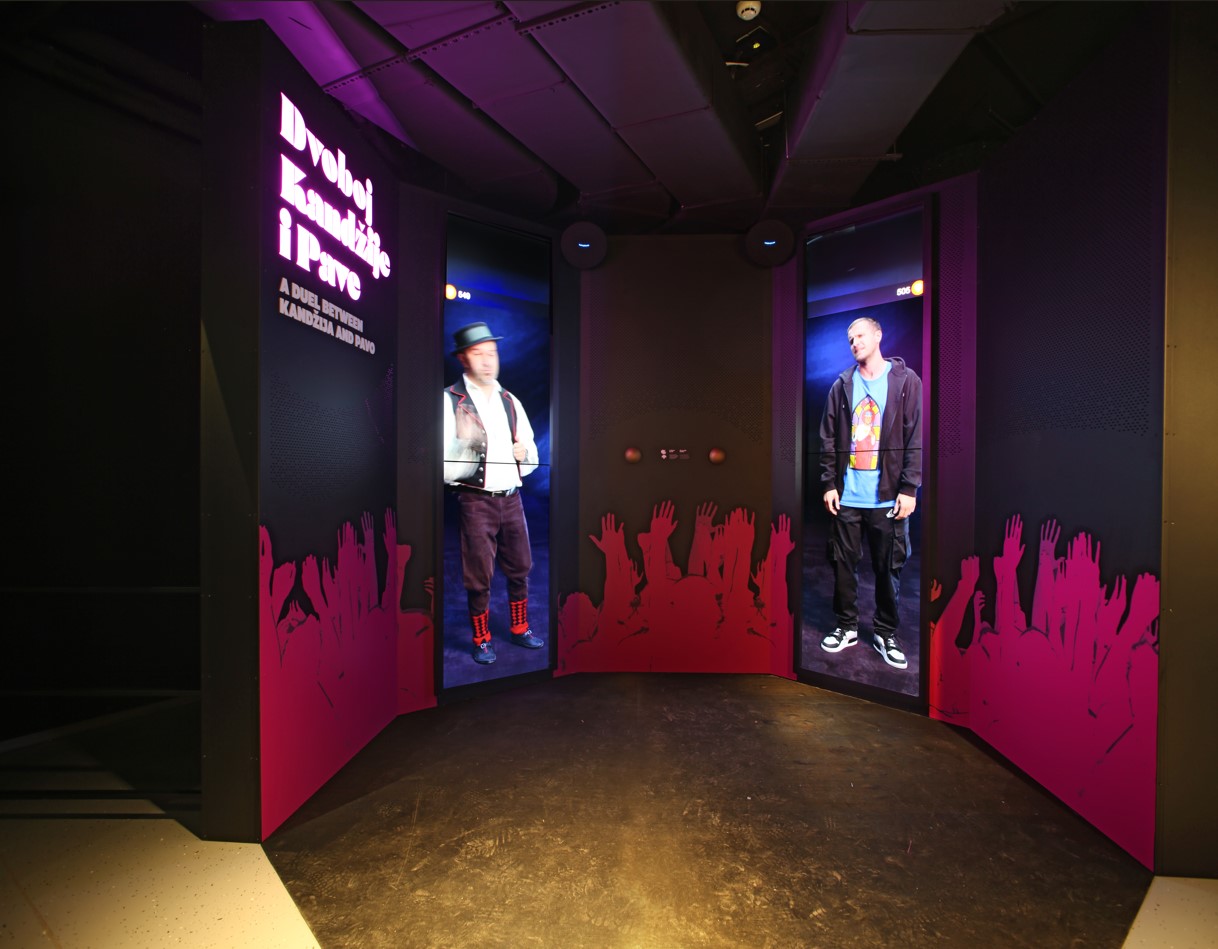
One of such centres, perhaps the pearl of Slavonia, is the recently opened Museum of Becarac in Pleternica. It is one of the few infrastructure projects specifically built to become a museum. The design was the vision of a famous Croatian architect Andrija Rusan, who also designed the arrangement of the central part of the city for Pleternica.

The strategic work we mentioned is best manifested in the interpretation of the centre, created by the Zagreb company Muze, in whose realisation over a thousand proud representatives of the Slavonian tradition from Slavonia, Baranja and Srijem participated. Also, in the attitude of the city leadership and the museum, the focus is on a broad view of tourism in the region. So if you ask the mayor of Pleternica, Marija Saric, how she sees the museum, she will say that it is the starting point of a tourist visit, part of the mosaic of the rich offer of the whole of Slavonia, Baranja, and Srijem.
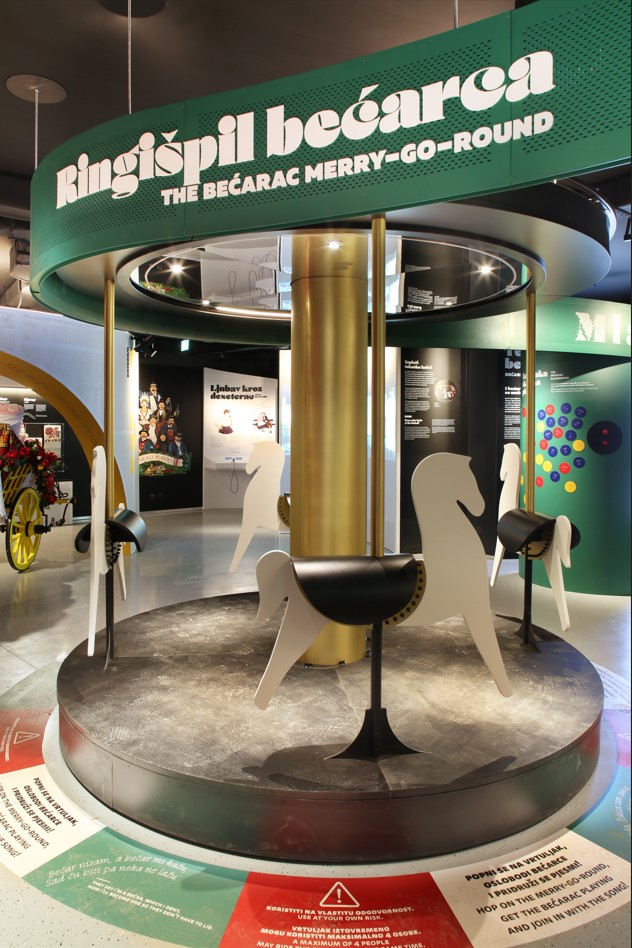
Part of Croatian cultural heritage, becarac is known as a form of humorous folk song that originates from Slavonia. It usually involves male singers dropping lascivious lines in front of a tipsy audience that roars from laughter at every rhyme – it's clever, sassy, and always a bit inappropriate. In 2011, bećarac was officially inscribed in UNESCO's Intangible Cultural Heritage list.
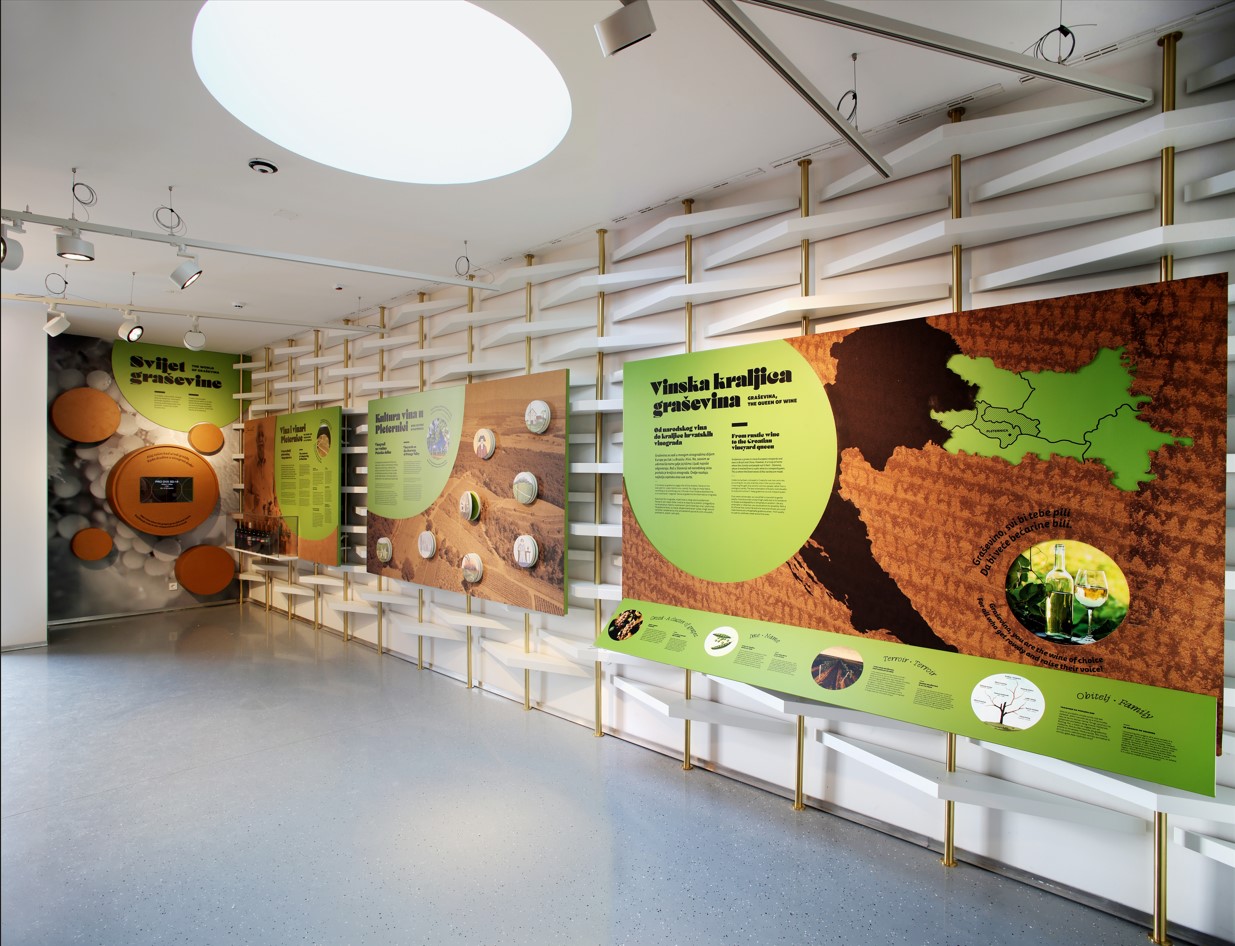
But what does that starting point offer? Everything you need to know about Slavonia on your first visit told, or rather sung in the form of becarac. The first exhibition is the only one you can see when you peek through the museum doors. It is called Mala kuća graševine (The little house of Graševina wine). It presents the rich wine history of Pleternica, the town itself, basic information, and a few interesting songs that will surely delight you. Of course, the theme of this exhibition is wine. Going down the stairs, a completely new world opens up, the world of becarac, and upon arrival, it is impossible to hide the smile on your face and the radiance caused by the song, the joy, the beauty of the folk costumes.
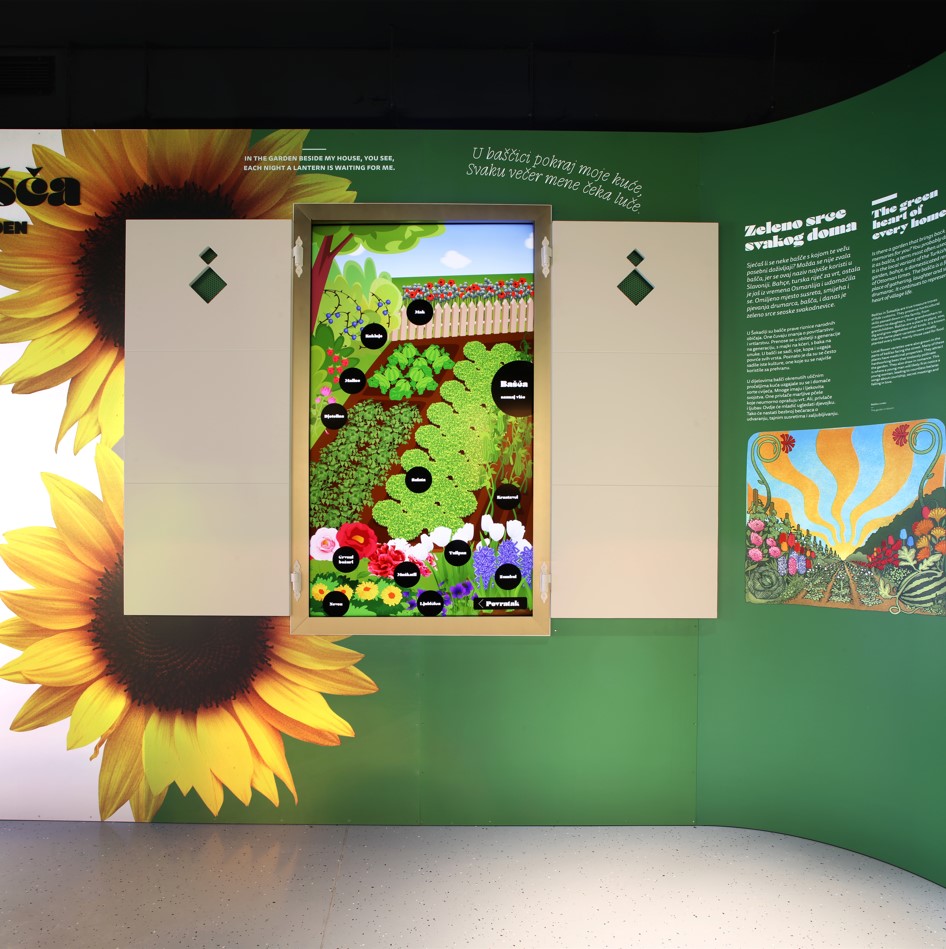
The lower and main part of the Museum consists of several exhibitions, of course, "Introduction to the world of becarac," followed by "Becarac through life," "Becarac calendar," and finally, "The becarac rhapsody." It would take a while to describe each of these, but what is interesting and hidden in the Museum is that it is not just about the song, but rather the whole life of a region is presented through becarac, down to the last detail.
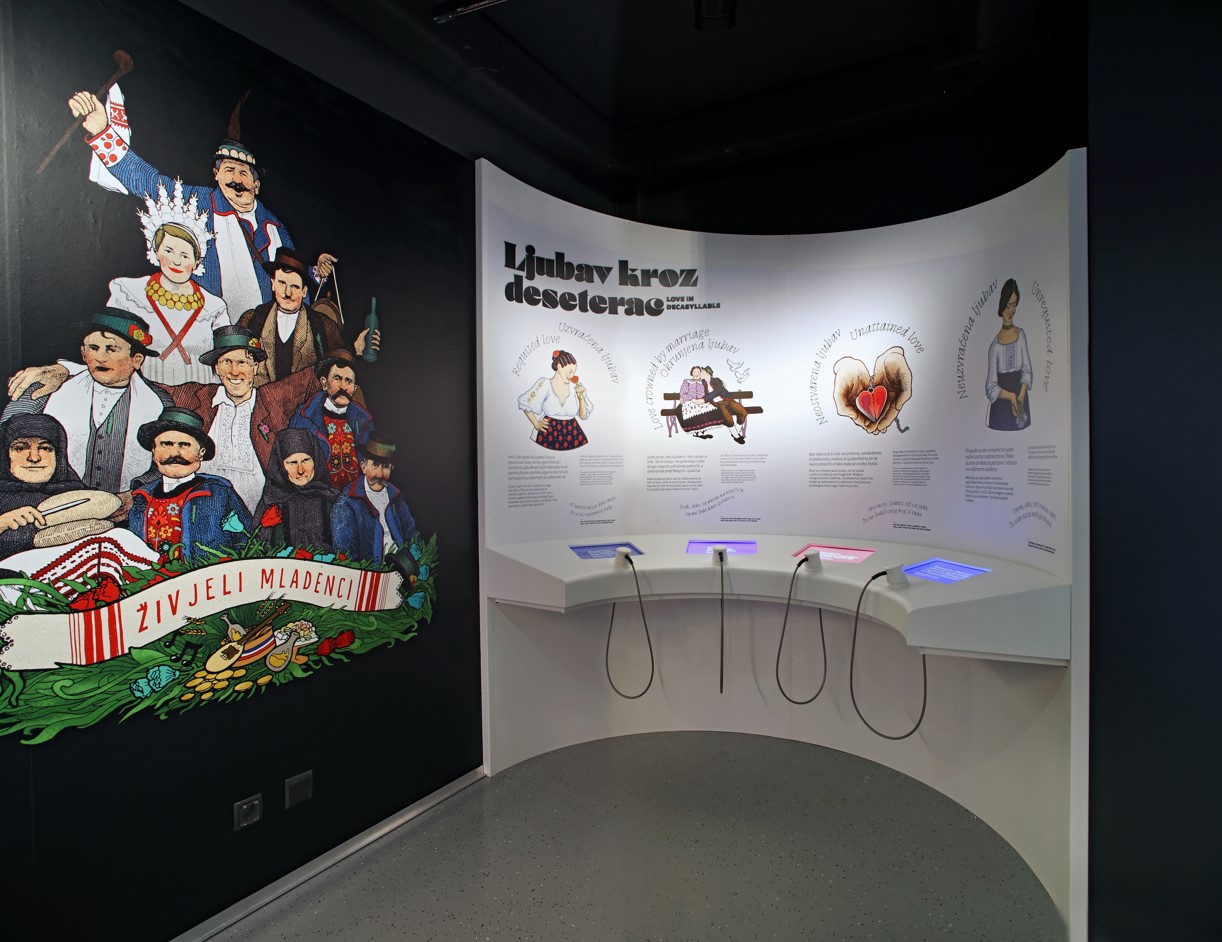
Multimedia exhibits guide you through the Museum, which you don't even realise since they are skillfully interpolated with the traditional museum setting, i.e., exhibits and artistic representations of specific segments. The Museum of Becarac in Pleternica is without a doubt a must-visit point not only for continental but also for national tourism. If we add to that the Terra Panonica Interpretation Centre, which also tells the ancient story of the Pannonian Sea, and is located right next to the Museum, maybe a train ride through the Pleternica vineyards, we can just conclude that you should leave time for Pleternica - everything else is waiting for you there.
For more, make sure to check out our dedicated Travel section.
Meet Slavonia 365, Full of Life - Iva and Mihovil of Castrum Gin
December 21, 2022 – Meet Slavonia 365, full of life. A year ago, TCN started Vukovar 365, the new series to show that there is life in the east of Croatia every day of the year. After Vukovar reigned the stage for a while, it is time to go beyond and tell more inspiring stories of Slavonia. For our exciting opener, meet Iva and Mihovil of Castrum Gin.
This young married couple worked in marketing and law in Zagreb, jobs they loved, but they decided to return and chase their dreams in their tiny home village of Kaptol near Požega. And they are doing so while sipping on some top-quality Slavonian gin. We spoke to them to find out how they do it, what inspired them to go gin instead of rakija, and why everyone should consider at least visiting Slavonia.
Introduce the people of Castrum and tell us about its visual identity.
We are Iva and Mihovil, a young married couple who started producing craft gin a year and a half ago in a small town at the foot of Papuk, Kaptol. Mihovil is a lawyer by profession, and I am an economist. Although we loved the jobs we did in Zagreb, we decided that we would prefer to live in a quieter place in the future. We both come from Slavonia, and Mihovil has been involved in the production of wine and brandy with his parents since he was a child, so distillation was a familiar concept to him before we ever decided to run a business with distillates.
Castrum is the name for two types of gins we produce - London dry gin and Barrel-aged gin. Its name was inspired by the medieval fortress that dominates Kaptol, whose shape is called a castrum. The shape of the fort is hexagonal with four associated towers, which we also used for the shape of our label. The logo mostly reminds people of lace, but it's actually a faler - an ornament from the horse bridles of Hallstatt warriors who lived above Kaptol in the early Iron Age. Falers were excavated precisely at the Kaptol-Čemernica archaeological site near our distillery.
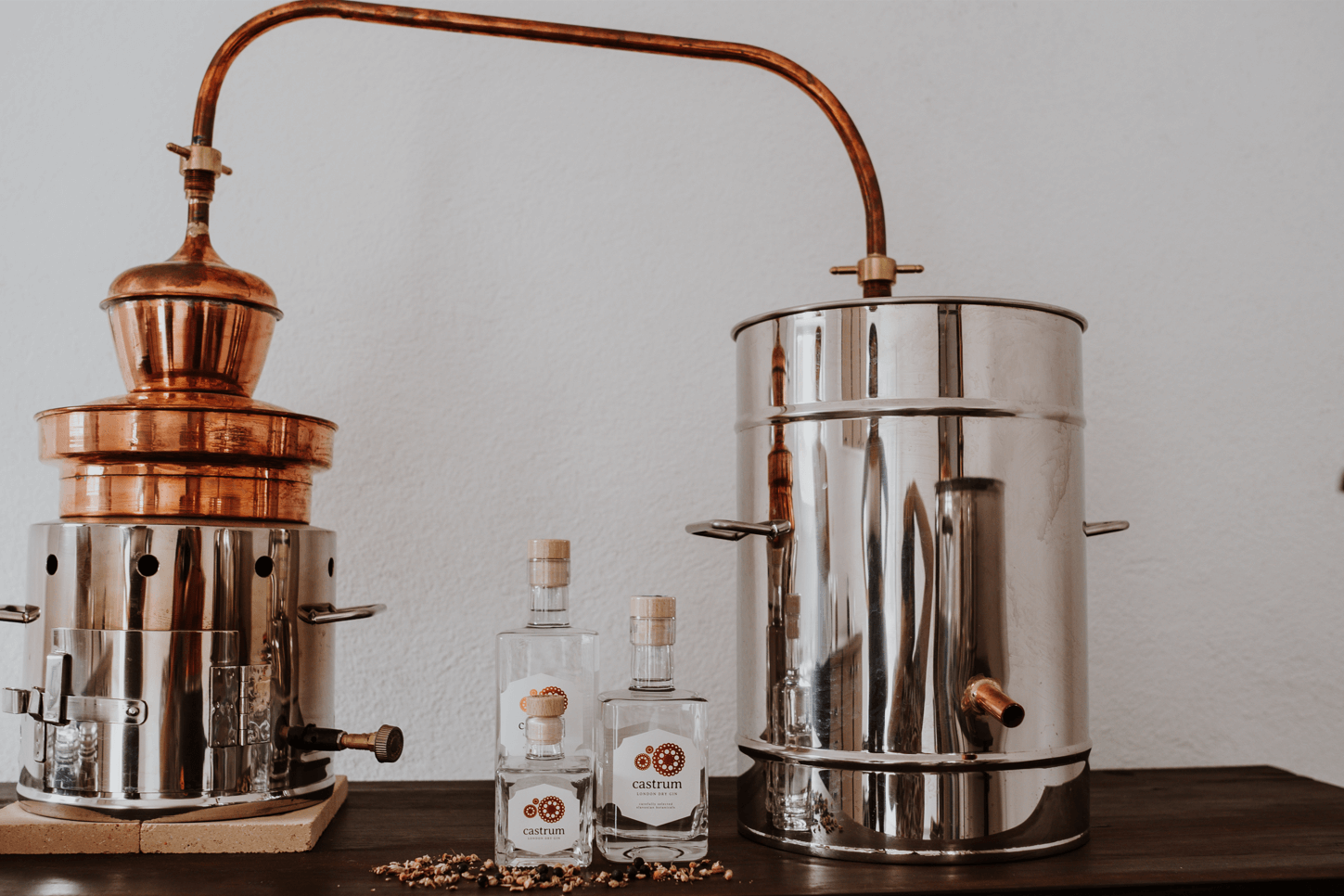
What inspired you to produce gin and not a more traditional drink like rakija? Tell us about your journey.
Gin is a drink we have both loved for a very long time, and we have tried many different types and brands. As for gin as our first distillate choice, it was carefully chosen. When we started thinking two and a half years ago about doing something that would allow us to make a decent living in Slavonia, we knew we needed an idea that would set us apart somehow. The idea of gin was born - precisely because it would be a somewhat "logical" sequence if we started to produce rakija in Slavonia and moved back from the big city, but I'm sure the whole story then wouldn't have been half as interesting.
Some new products are coming, which and how will they be special?
We plan to produce two types of rakija, quince and viljemovka, but before that, we will market pelinkovac (bitter wormwood liqueur) with an interesting name. That one will also be interesting due to ingredients associated with Slavonia, which are not typical for pelinkovac itself. We have a great desire to age a real Slavonian whiskey as well.
You have a gin garden; how does that work? Where do your visitors usually come from?
Our entire distillery is housed in an extension of my husband's parents' home. Since we would also sell our gin there, we created a small cozy area in the basement with a table and six chairs where our guests can sit when they come to shop or for a tasting. At that time, we did not think that a larger group of people would want to visit; we predicted it in the distant future, but it came very quickly. Since we still need to design a larger space for tastings, we came up with the idea of a gin garden during summer. Then the entire lawn in our backyard is occupied by pallets and old things from our grandparents' houses - armchairs, sewing machines, old irons, etc. It is a unique experience in the evening since the whole setup is between apple and pear trees, where we hang fairy lights, which makes it beautiful in the summer evenings. The gin garden opens when the temperatures make spending time outdoors comfortable, usually from the end of May until mid-September. Visitors come to us from all parts of our beautiful country, mainly from Zagreb. We are glad our location is becoming a top choice for weekend trips. There are many tourists in summer, but their number increases significantly in autumn and spring.

How did the fact that you are located in the east of Croatia affect your business?
It had a favourable effect on us, probably because, by returning to Slavonia, we were able to place a very trendy drink on this market, which also quickly found its place under the sun due to its quality.
You are a marketing expert. It seems that Castrum and Slavonia are an inseparable duo. Tell us about this symbiosis.
Ah, Slavonia without Castrum as a gin brand has indeed existed all this time, but a castrum has been standing there since the Middle Ages! During our brand design, we were guided by the idea that our entire product would tell a story - from the ingredients themselves to the connection with the location. I believe that to be very important, it gives personality to the brand, and people connect with it more easily. We produce gin in Slavonia, so we made sure to use ingredients that are characteristic of the area. In our gins, those are elderberry, black mulberry, and grapevine. By returning to Slavonia, we also wanted to work on promoting our destination. I think that by connecting branding with history, we have created a wonderful symbiosis that ultimately offers a tourist experience.
Tell us about tourism in that part of Slavonia - is there tourist potential, and why should everyone visit?
There is significant tourist potential here, and I am glad that this potential is being exploited more and more. Many people have visited our distillery from all parts of Croatia, as well as from abroad. We are happy to host ‘our’ people, who went to Germany, Austria, Switzerland, and even Sweden to earn their living. They somehow get particularly emotional since they wish they could have stayed in their hometown and done something which would provide them with a good life.
There are many reasons why to visit Slavonia. Untouched nature is undoubtedly one of them. The forest park Jankovac is beautiful in all seasons; there are so many cycling and walking paths; our entire region is full of excellent wines and wineries that everyone should visit. There are also many educational places, and there is plenty of content for the youngest.
Having come back, we completed the story of the "return" of our entire team. We were eight enthusiasts who wanted to show our area to more people. We all lived outside Slavonia at one point, and some even on another continent. We designed the event "Ideš i piješ" (Drink as You Go), which works according to Wine and Walk principles. Participants walk 12 kilometers through Papuk and meet local winemakers and distillers. This year was the second in a row, and we can say that the interest is huge. Registration fees were sold out in just ten days, and our inbox was full of questions about whether other places would be open. Slowly but surely, Slavonia is finding its place on the must-visit map. I think that the pandemic also contributed to this. We were limited in terms of travel, so we turned to travel in our own country. At least something beautiful came of such an ugly crisis.
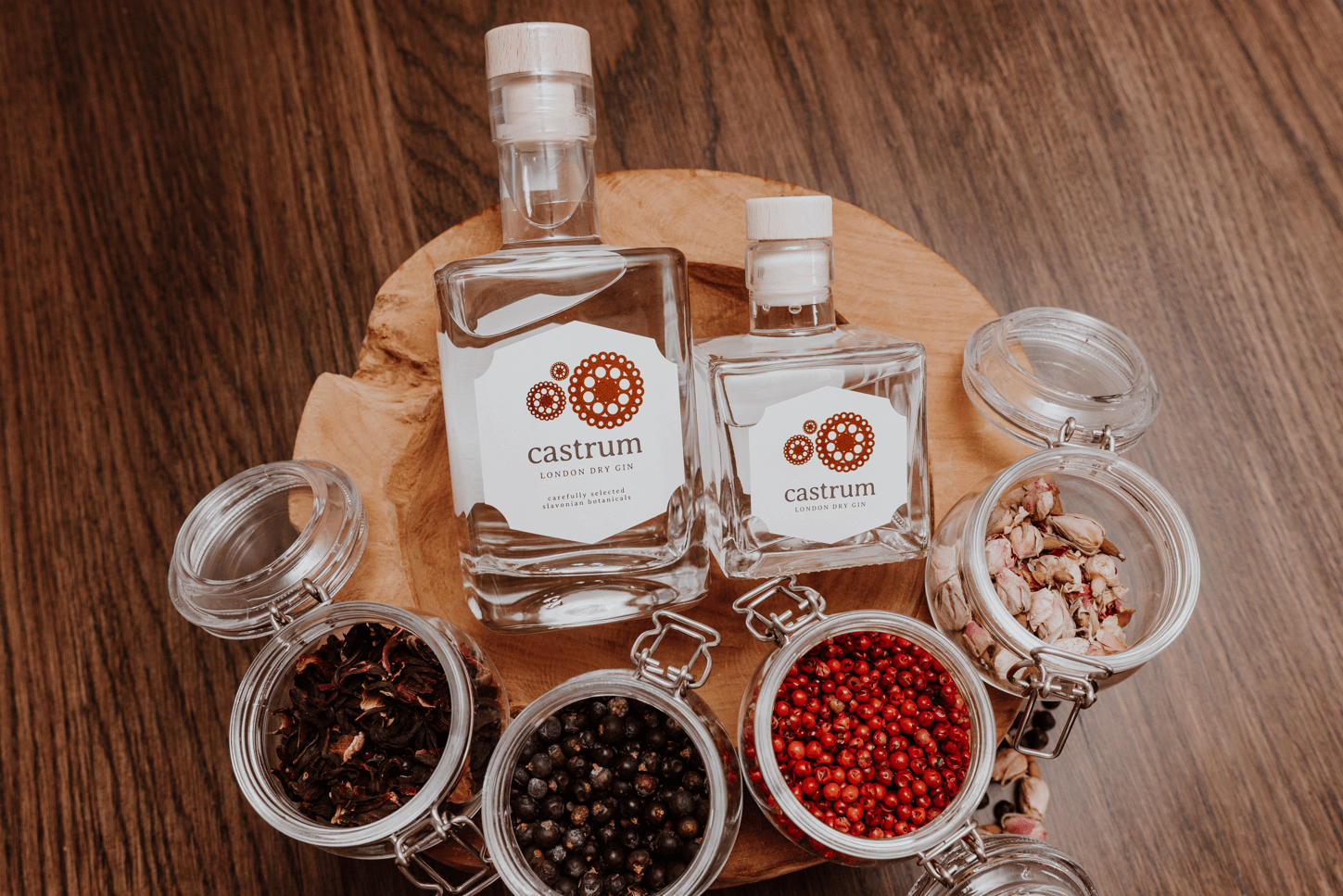
Where can we find you and your product, how long does delivery take? Are we late for Christmas shopping?
So far, we have yet to enter large retail chains, so our products can be found in smaller specialised stores. A list of them can be found on our website, through which our products can be ordered. Delivery takes 1-3 working days. Of course, that deadline could be extended these days by a day or two. As for being late for Christmas shopping, I think it's never too late for good presents!
For more, make sure to check out our dedicated Lifestyle section.
Osijek Airport: Direct Connections to Six Destinations for Advent
December 20, 2022 - If you've always wanted to visit the east of Croatia but hesitated because it's been a bit far, your time might have just come. The Osijek airport is now directly connected to six destinations: Zagreb, Split, Rijeka, Dubrovnik, Pula, and the Croatian Gastarbeiter mecca, Munich.
As Jolie.hr writes, Advent is the right time to visit continental Croatia. And Osijek Airport provides direct flights to this Eastern Croatian metropolis from the Croatian cities. You can also visit Osijek by direct flight from the Bavarian capital of Munich. Osijek Advent was declared the best in Croatia in 2021, and this year it shines with the glow of thousands of lights. Take a walk along the path of holiday magic from the art nouveau European Avenue to the fairytale Fortress, where you will find an abundance of smells and tastes of Christmas.
A rich cultural and entertainment program at the Fortress
This year's Advent is a real opportunity for family quality time, where everyone can find something for themselves. The youngest will be able to enjoy fairy tales in the Great Winter Story Room, watch cartoons in the Christmas Cinema, and write letters to Santa Claus! Concerts, lectures, exhibitions in the Archaeological Museum, and gastronomic mornings have been prepared for the big ones. Celebrated chef Rene Bakalović will create New Slavonian cuisine for visitors, preparing the most delicious Slavonian dishes in a modern way.
The ice fairy tale of the ice rink at Sokol offers unforgettable moments to young and old lovers of winter joys, and after showing off your skating skills, you will have the opportunity to warm up with mulled wine or dance to Christmas hits. And if you are not of an adventurous spirit and enjoy walking around the city more, explore the hidden parts of the city whose every corner breathes holiday magic and a Christmas atmosphere.
The most beautiful view from 35 metres
An essential part of Advent this year is the "panoramic wheel" that will take you high above the city’s rooftops. The largest Ferris wheel in Croatia is located at the Baroque Fortress, where you can enjoy a wonderful view of the city. The daytime ride places the fairy-tale city below your feet, and the night ride provides a view of thousands of lights. This year's Advent programme lasts until the 30th of December, and if you decide to spend the craziest night of the year on the streets of Osijek, the band Crvena Jabuka will count you down into the New Year on the central town square.
Visit the beautiful Baranja and the Danube region
Along with the Osijek Advent tour, you can visit the Vukovar Christmas market or the restored Eltz manor museum. After the New Year's celebration, you can enjoy the rich gastronomic offer of Baranja. Go on a tour of the wine cellars and enjoy traditional Baranja delicacies. The Slavonian metropolis has never been closer - visit Osijek and see why it won the title of the most successful continental city tourism destination! More information on the Osijek Airport website.
For more, make sure to check out our dedicated Travel section.
WineOs - 8th Edition of Osijek Wine Fair Featuring Exclusive Workshops
December 18, 2022 - The New Year is approaching, and with it, a real treat for true hedonists - WineOS. The eighth edition of the fair of wine, delicacies, and pleasant living will once again offer its visitors exciting content and the best wines and delicacies from eastern Croatia, as well as guests from other parts of Croatia and abroad. It is happening at the traditional Gradski Vrt venue in Osijek.
As SiB writes, one of the biggest lures for many wine lovers will be the wine workshops organised by the famous wine author Željko Garmaz. Speaking of popular wine stories, which regularly attract guests to WineOS, the biggest novelty is that starting next year, there will be even more workshops, and they will take place over three days, January 12, 13, and 14. Therefore, eleven excellent workshops await on Thursday, Friday, and Saturday, featuring interesting, exclusive, and attractive topics, winemakers, and wines.
Three different topics will be explored on the first day, Thursday, January 12. At 3 p.m., representatives of Belje, one of the largest and most important wineries in eastern Croatia, will go on a journey through time into the wine past. That is, of course, tasting archival wines with interesting stories around their creation. From 4:30 p.m., sommelier Klaudio Jurčić, who has ventured into the wine industry, will talk about his friendships with winemakers while the guests are tasting his wines. The last workshop of the day, which starts at 6 p.m., is also a treat and will lure all true wine lovers. The famous Hungarian winemaker from Villany, Attila Gera, will present a vertical of his black coupage from the Kopar location.
On Friday, January 13, four workshops are scheduled, and the program will be opened at 1 p.m. by Gianfranco Kozlović with a vertical of his malvasia. At 2:30 p.m., all visitors will have the opportunity to meet another Istrian, Bruno Trapan, and his Uroboros, or aged malvasia. From Istria, at 4 p.m., the visitors can move to Fruška Gora and the Erdevik winery, which will present a vertical of its award-winning Omnibus Lector chardonnay. From 5.30 p.m., the story of the village of Umčani from the Vrgorac region and the Gašpar brothers will round it all up.
On Saturday, January 14, four unique workshops will take place as well. At 1:00 p.m., the visitors will have the opportunity to get to know the top-quality wines from the Croatian winery of the famous Mike Grgich. An hour and a half later, the story about the expansion of the Galić winery in Dalmatia and getting to know the "sea ego" of Jozo Galić is on the schedule. At 4:00 p.m., another treat for lovers of unique and different wines – a workshop of kadarka from Oszkár Maurer's cellar. The end of the programme is dedicated to the Herzegovinian winery Nuić and the native variety trnjak.
Finally, let's note that tickets can only be purchased in advance at the Viniti wine shop. Reservations can be made by e-mail at This email address is being protected from spambots. You need JavaScript enabled to view it. or by phone at 098/1747-108. The price of individual tickets is HRK 150 or HRK 200 (depending on the workshop), while daily packages cost HRK 500 each. There are 20 tickets for each workshop, so get in touch as soon as possible to reserve your spot! You can find more information about the workshops on the WineOS website.
Strong Tourist Season in Baranja, More in Store for the Winter
November 2, 2022 - As early as in mid-September, the number of overnight stays in Baranja was equal to the total number of overnight stays achieved in 2019, which means that the record has already been exceeded.
Glas Slavonije reported on the positive trend which this eastern Croatian region has been enjoying. "Judging by the inquiries and planned events, we are expecting a great tourist year", said Matej Perkušić, director of the Baranja Tourist Board, stressing that it is obvious that, above all, domestic guests have acquired a new habit, "to travel and spend nights within Croatia, including Baranja."
He reminds that there is no season or postseason on the "continent", which is confirmed by the numerous visitors to several events in Slavonia-Baranja during the past months. Željka Bagarić-Dumančić from the Baranja Tourist Board claims that guests will have a reason to come to Baranja (but also a bit more).
"Let's start with the events included in the celebration of the Day of Beli Manastir, Martinje. Among the whole series of different and interesting month-long events organised by the City, Beli Manastir associations and institutions, I single out the preparation of traditional Baranja fish dishes, which will be held on November 5 in the Hungarian House of MKU Pelmonostor. On the very Day of Beli Manastir, a concert by the tambura group Fijaker is planned, and the day after a fair of local products with a rich gastronomic offer", said Bagarić-Dumančić.
Steve Tsentserensky
Many guests will also be attracted by the traditional Karanac Winter Fair and Čvarak Fest on November 26 at the Karanac Field, organised by the Association of Keepers of Old Crafts (Udruga čuvara starih zanata), with the help of Baranjska Kuća and Baranja Tourist Board. This year too, visitors will be welcomed by numerous stands, a rich gastronomic offer and interesting content. This year's novelty is the winter Wine & Walk. So far, only the summer one has been held, and due to numerous inquiries from the participants, the local tourist board, in cooperation with the Baranja Winegrowers Association, decided to organise one during the colder part of the year as well. It will be held on December 10.
Steve Tsentserensky
"We expect between 200 and 300 participants. On the nine-kilometer-long trail through Suza and Zmajevac, the famous wine meccas of Baranja, participants will be welcomed at numerous locations by Baranja winemakers and restaurants with top-quality wines and snacks. We will provide the walkers with a map, a wine glass and a winter hat, and the participants will need to make sure they wear comfortable clothes and shoes and a good mood", explains Bagarić-Dumančić, adding that the wineries Pinkert, Kovač, Kolar, Horvat, Gerštmajer, Svijetli dvori, Zlatno brdo, Kalazić, Josić, Szabo and Kusić will be waiting for the walkers. The energy will be taken care of (also) by the Kovač Čarda restaurant, the Oaza Mira vacation house, the "Tako je to nekad bilo" (As It Once Was) association, the Borarium Vinarium, and the Kusić cellars. The registration fee is HRK 300. The afterparty is in Katolički Surduk. Finally, let us not forget the Baranja Advent (Christmas markets) in Kneževi Vinogradi and Beli Manastir.
For more, make sure to check out our dedicated Travel section.


